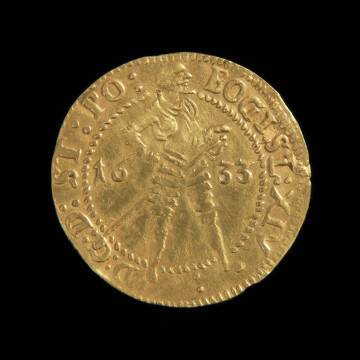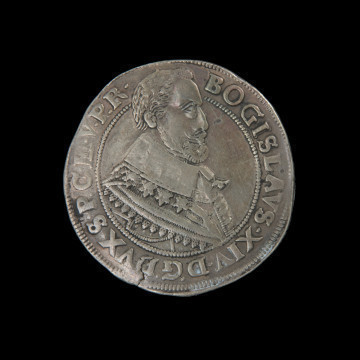
Ducat
1635
National Museum in Szczecin
Part of the collection: Pomeranian coins
The minting of Duke Bogislaw XIV was entirely in the period of the Thirty Years' War (1618-1648). The policy of neutrality pursued by the Griffins only temporarily averted the spectre of the country's occupation. In 1627, the War reached the borders of the Duchy, which, under pressure, accepted the imperial army on its territory. Maintaining a foreign army consumed vast amounts of money and led to an economic disaster. The lack of coins in circulation forced Duke Bogislaw XIV to open an additional mint in Koszalin. Its activity was illegal since only one mint in Szczecin could function in the Duchy under the Reich's monetary law. In 1628-1636, intensive production was carried out in both mints, but the benefits were reaped by foreign troops, not the state treasury. Gold coins - guilders and ducats - were used mainly to pay the salaries of high-ranking officers stationed in West Pomerania. For the first time, the Duke's image was in a standing position, in parade armour, with a sword and a club on the stamps of ducats. Bogislaw XIV was in a representative pose as an ideal knight and ruler. What draws attention is a clear display of militaria despite the tragic situation of the country, the Duke's illness and partial paralysis. The coin's obverse refers to the Dutch model of ducats, which spread in Europe in the 17th and 18th centuries. The letters V-B appearing on Koszalin ducats in 1633-1636 belong to the administrator Ulrich Bütkow. Apart from the signature, ducats from the Koszalin mint are distinguished by the symbol of a cross in the central part of a ten-field shield and the Bishop of Kamień Pomorski title in the Duke's extended royal titles. We do not know who the author of the stamps was. Still, the good artistic level and the iconographic similarity to the Koszalin thalers signed by the Szczecin goldsmith Gottfried Tabbert allow us to assume that it is also his work. After the death of the last Pomeranian Duke in 1637, the mint in Koszalin was closed forever. The Swedish rulers initially minted coins in Szczecin, and after losing the city in 1713, the mint was moved to Stralsund, the new seat of the Pomeranian provincial government.
Genowefa Horoszko
Other names
Dukat
Author / creator
Dimensions
cały obiekt: height: 0.8 mm, diameter: 23.3 mm
Object type
coin
Technique
minting
Material
gold
Creation time / dating
Creation / finding place
Owner
National Museum in Szczecin
Identification number
Location / status

1635
National Museum in Szczecin

1631
National Museum in Szczecin

1636
National Museum in Szczecin
DISCOVER this TOPIC
Museum of King Jan III's Palace at Wilanów
DISCOVER this PATH
Educational path